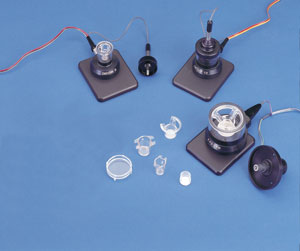 The EndOhm series of chambers, when used with WPI’s EVOM2 resistance meter or the EVOM-Manual, are designed to provide reproducible and accurate resistance measurements of endothelial tissue in culture cups. Resistance values obtained with the EndOhm are consistent with those obtained using a well-designed Ussing Chamber.
The EndOhm series of chambers, when used with WPI’s EVOM2 resistance meter or the EVOM-Manual, are designed to provide reproducible and accurate resistance measurements of endothelial tissue in culture cups. Resistance values obtained with the EndOhm are consistent with those obtained using a well-designed Ussing Chamber.
If an EndOhm is properly cared for, it will enjoy a much longer life. In this article, we will examine how often and what method should be used for cleaning an EndOhm electrode.
How Do I Clean the EndOhm?
With use, the electrode surface can become coated with protein or other foreign materials. This build-up, or contamination, can degrade the performance of the system. After every use, rinse the EndOhm electrodes with distilled water and store them dry.
Routine Cleaning
Clean the EndOhm with distilled water and standard biological detergents (such as Endozime) unless a change in the baseline performance becomes evident. The baseline performance of the EndOhm should be established when the probe is new. This will serve as the reference by which the performance of the EndOhm can be judged as it ages.
Deep Cleaning
Periodically clean your EndOhm chambers with Tergazyme, a proteolytic detergent manufactured by Alconox.
When performance begins to degrade, then a more aggressive cleaning technique may be considered. Consistent rinsing with distilled water immediately after use, cleaning with Endozime and storing the EndOhm dry when it’s not in use should go a long way to keeping it working well. As far as more aggressive cleaning is concerned, the thing to watch out for is an increase in baseline TEER. Baseline TEER will increase if an accumulation of biological material, such as proteins, adhere to the surface of the voltage and current electrodes, because they can act as a barrier and increase the electrical resistance of the voltage measurement electrodes. These materials can be removed with a proteolytic enzyme or an alternative solvent specific to the suspected contaminant, as long as it is not aggressively reactive with the materials.
- Rinse with the electrodes with distilled water and dry them.
- Make a 1% solution of Tergazyme according to the manufacturer's instructions.
- Suspend the tips of the electrodes in the Tergazyme solution, with the exposed electrode surfaces fully immersed. During soaking, the surfaces of the electrodes may be brushed with a soft brush (like a tooth brush), if desired. The soaking time varies according to your maintenance schedule and the frequency of your cleaning.
- Soak overnight when the EndOhm has not been on a routine maintenance cleaning schedule.
- Soak 30–60 minutes if you are on a weekly cleaning schedule.
- Soak 5 minutes if you clean your electrodes daily.
- Rinse well with distilled or de-ionized water. Allow them to air dry and store the electrodes dry away from exposure to sunlight.
Will Bleach Hurt the Endohm?
The EndOhm is constructed of (acrylic, epoxy, silver and silver chloride). So, it won’t hurt to expose the probe to bleach once in a while to rejuvenate the silver chloride layer on the electrodes.





Request
Catalogue
Chat
Print